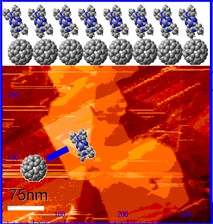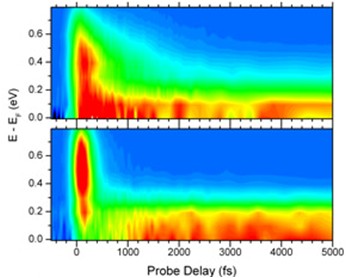 Molecular
Molecular
semiconductors are important materials for technology applications, such as
solar cells. Current research focuses on how to organize molecules at interfaces for more efficient energy
conversion. Maryland MRSEC researchers
and NIST collaborators recently showed
how the arrangement of molecules at a molecular junction impacts energy
conversion. Ultrafast electron transfer takes place when electron-donating CuPc charge transfer, leading to more
efficient devices molecules “stand up”
on their electron-accepting C60 neighbors. Such oriented molecular interfaces
enhance.

The electron
population is followed at oriented CuPc:C60 interfaces as a function of time
with two-photon photoemission. Electrons
are first optically pumped in the CuPc layer, appearing as the bright red streak at short
times.
Upper Panel: 5 nm Thick CuPc film - Electrons must first diffuse through the CuPc
transferring to C60 on an
800 fsec time scale. multilayer before
Lower Panel: 1 nm Thick CuPc Film - Electrons transfer from the single-layer ZnPc film to C60 within
150 fsec. For this open-circuit structure, electrons
return to ZnPc at longer times,
appearing as a red horizontal streak after 1000 fsec.